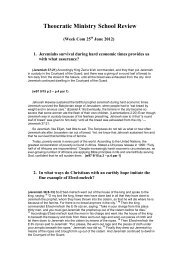1964 Awake! - Theocratic Collector.com
1964 Awake! - Theocratic Collector.com
1964 Awake! - Theocratic Collector.com
You also want an ePaper? Increase the reach of your titles
YUMPU automatically turns print PDFs into web optimized ePapers that Google loves.
the middle of the eighth century when the<br />
Arabs captured Samarkand and, with it,<br />
several Chinese workmen newly arrived<br />
ther.e for a recently erected paper factory.<br />
In 793 a paper mill was built in Baghdad,<br />
and there paper became so diversified as to<br />
include extra-thin sheets for "airmail" by<br />
pigeon post.<br />
This all-essential material of modern<br />
printing did not reach Spain, the pivot<br />
point between Arab and European civilizations,<br />
until 1150 and dallied along until<br />
the fourteenth century before arriving in<br />
Germany.<br />
Thus the nation of Gutenberg was some<br />
thirteen centuries behind China, whose<br />
government official, Tsai Lun, in the year<br />
A.D. 105 mixed up a pulp from rags, mulberry<br />
bark, hemp and grass, ladled it onto<br />
a sieve and watched it dry into a kind of<br />
fleece. Taken from the sieve and fully<br />
dried, it could then be smoothed into a<br />
good writing sheet by lise of alum or other<br />
sizing.<br />
With the Oriental" getting the tools of<br />
the graphic arts in their hands so early,<br />
it is really not surprising that the Chinese<br />
and Japanese were printing from engraved<br />
blocks in the first millennium A.D. Already<br />
in the sixth (:cntury Chinese artisans were<br />
carving wood blocks for a whole page at a<br />
time; by the eleventh century they had<br />
advanced to using individual wood characters<br />
that could be reset for new texts.<br />
By about 1390 the related Korean people<br />
had movable metal type that could be cast<br />
quickly and was more durable. Europe did<br />
not produce the elemental woodcut for capitalletters<br />
in handwritten manuscripts before<br />
the mid-twelfth century.<br />
All this does not necessarily indicate<br />
that Europe borrowed its printing techniques<br />
from thE' Orient, for developments<br />
26<br />
in Europe followed quite different lines<br />
ftom those in China. But that does not rule<br />
out the possibility, Lilley contends, that<br />
Europe got word of Chinese printing and<br />
then set about to do the same thing in its<br />
own way.<br />
As for the modern jet aircraft that<br />
climbs so steeply and hurtles its passengers<br />
so swiftly to their destination, its<br />
<strong>com</strong>plex marvels are based on simple principles<br />
of flight learned long centuries ago.<br />
"The key to the problem of mechanical<br />
flight," says Egan Larsen in his book A<br />
History of Invention, is the kite. And<br />
where did the kite get its start? "Traditionally,<br />
the invention of this plaything is<br />
ascribed to one Archytas of Taremtum in<br />
the fourth century B.C., but the Chinese,<br />
ihe Koreans, and other Far Eastern nations<br />
have known it for much longer." Before<br />
the introduction of practical aircraft,<br />
numerous successful man-carrying kites<br />
were built, and some were used in the<br />
Russo-Japanese War.<br />
But, really, how did man learn such<br />
things as the principles of flight? As with<br />
many of man's inventions, creation with<br />
all its phenomena had them first; and man<br />
learned by observing God's creation.<br />
Looking back on the things the East had<br />
first, how good a grade would you have<br />
gotten in a quiz on the subject? "Ah, well,"<br />
you might say, "I would have named tea<br />
and silk and printing and chop suey."<br />
But be careful not to be too sure of yourself.<br />
Actually chop suey, a food now served<br />
in restaurants in many parts of the world,<br />
originated in the United States. The words<br />
<strong>com</strong>e from the Chinese and mean "miscellaneous<br />
pieces," but despite its name, chop<br />
suey is not a genuine Chinese dish.<br />
Which goes to show that what people<br />
"know" is not always so.<br />
AWAKE!<br />
•




